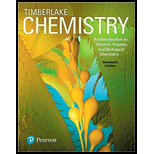
Concept explainers
Calculate each of the following:
a. number of Li atoms in 4.5 moles of Li
b. number of
d. moles of
Want to see the full answer?
Check out a sample textbook solution
Chapter 7 Solutions
Chemistry: An Introduction to General, Organic, and Biological Chemistry (13th Edition)
- Calculate the amount (moles) represented by each of the following: (a) 127.08 g of Cu (b) 0.012 g of lithium (c) 5.0 mg of americium (d) 6.75 g of Alarrow_forwardCalculate each of the following quantities in 2.20 moles H3PO4: moles of H and moles of Oarrow_forwardWhat is the mass in gram of oxygen atoms in 0.305 mol Fe2O3? (Molar mass of O = 16.00 g/mole) (Hint: the molar ratio is ( 3 mole of O/ 1 mole of Fe2O3), find how many mole of O in 0.305 mole of Fe2O3. Then, convert the mole of O to gram by using the molar mass of O)arrow_forward
- Calculate each of the following (Show Work): a. the number of formula units of KCl in 3.8 mol of KCl b. the number of CO2 molecules in 2.70 mol of CO2 c. the moles of Fe in a sample containing 5.72 x1021 atoms of Fearrow_forwardThe formula for sulfur tetrafluoride is SF4. a. How many grams of sulfur are present in 3.28 moles of sulfur tetrafluoride? grams b. How many moles of fluorine are present in 4.73 grams of sulfur tetrafluoride? molesarrow_forwardCalculate each of the following quantities in 0.190 mol of C6H14O. A. Calculate the number of moles of C (nC). B. Calculate the number of moles of O (nO). C. Calculate the number of atoms of H (NH). D. Calculate the number of atoms of C (NC).arrow_forward
- 1. Ethanol has a molecular formula of CH3CH2OH. a. What is the molar mass of ethanol? b. What is the mass of 0.562 moles of ethanol? c. How many moles of ethanol are present in a 100.0 g sample of ethanol? d. How many moles of carbon atoms are present in a 100.0 g sample of ethanol? e. How many grams of carbon are present in a 100.0 g sample of ethanol?arrow_forwardCombustion of 8.732 mg of an unknown organic compound gave 16.432 mg of CO2 and 2.840 mg of H2O. (a) Find the wt% C and H in the substance. (b) Find the smallest reasonable integer mole ratio of C:H in the compound.arrow_forwardThe following may be needed: 1 mol=6.022x1023. 1) Calculate the molecular mass and molar mass of CCl4. 2) How many moles of CCl4 are in 68.0 g of CCl4? 3) How many atoms of Li are in 73 g of Li? 4) How many moles of Pare in 25 moles of calcium phosphate?arrow_forward
- Freon is a trade name for a group of gaseous compounds once used as propellants in aerosol cans. Which has a higher percentage of chlorine: Freon-12 (CCl2F2) or Freon-141b (C2H3Cl2F)? Freon-12, because 59% of its atoms are chlorine. Freon-12, because it contains 58.63% Cl. Freon-141b, because 60% of its atoms are chlorine. More information is needed to answer this question. Freon-141b, because it contains 60.62% Cl.arrow_forwardNaHCO3 is the active ingredient in baking soda. How many grams of oxygen are in 0.42 g of NaHCO3? Molar mas of NaHCO3 = 84.01 g/mole and O = 16.00 g/mole.arrow_forward1.) The average cup of coffee contains about 125 mg of caffeine, C8H10N4O2. a.) How many moles of caffeine are in a cup? b.) How many moles of N are there in 125 mg caffeine? c.) How many molecules of caffeine?arrow_forward
 Chemistry for Engineering StudentsChemistryISBN:9781285199023Author:Lawrence S. Brown, Tom HolmePublisher:Cengage Learning
Chemistry for Engineering StudentsChemistryISBN:9781285199023Author:Lawrence S. Brown, Tom HolmePublisher:Cengage Learning Chemistry for Engineering StudentsChemistryISBN:9781337398909Author:Lawrence S. Brown, Tom HolmePublisher:Cengage Learning
Chemistry for Engineering StudentsChemistryISBN:9781337398909Author:Lawrence S. Brown, Tom HolmePublisher:Cengage Learning Chemistry & Chemical ReactivityChemistryISBN:9781133949640Author:John C. Kotz, Paul M. Treichel, John Townsend, David TreichelPublisher:Cengage Learning
Chemistry & Chemical ReactivityChemistryISBN:9781133949640Author:John C. Kotz, Paul M. Treichel, John Townsend, David TreichelPublisher:Cengage Learning Chemistry & Chemical ReactivityChemistryISBN:9781337399074Author:John C. Kotz, Paul M. Treichel, John Townsend, David TreichelPublisher:Cengage Learning
Chemistry & Chemical ReactivityChemistryISBN:9781337399074Author:John C. Kotz, Paul M. Treichel, John Townsend, David TreichelPublisher:Cengage Learning



